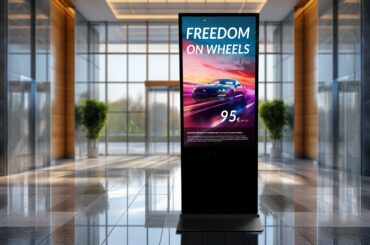„Technological innovations and a hyper-connected world have significantly influenced consumer behaviors and expectations. As a result, retailers are faced with a scary reality: Change or become obsolete.”
– Forbes, Bashar Nejdawi, CEO of Global Wireless Business Unit –
Thanks to the internet, we now have the ability to build networks for ourselves in ways that we would once never even have dreamed of. Let’s go one step further today and shed some light on a development that goes far further than anything that the internet has given us so far.
It could justly be called the development of a new era — and the transformation that this entails will be ubiquitous.
Technologies are being developed at a breakneck pace, while costs and sizes are reducing. Customer expectations are reaching new levels and ways of doing business in the retail sector require continuous modernization.
Connectivity is the new way of doing things, resulting in a world in which technology, consumption habits, and the internet all converge, interacting and communicating with one another. This phenomenon is opening completely new doors for our everyday lives, for businesses and, most of all, for marketing. Everything will change.
Retailers, in particular, must see this as an opportunity, not as a threat. The online and offline worlds no longer exist as discrete entities: instead, the internet is ubiquitous. Online and offline channels exist in a symbiotic relationship with one another and add completely new dimensions to our ways of communicating.
Online and offline exist in a symbiotic relationship with one another and add completely new chances to our ways of communicating
Businesses that continue to turn away from the internet will no longer be able to meet their customers’ growing expectations.
The development that is driving this transformation is called the Internet of Things, which the online and marketing expert Neil Patel describes as follows:
“The Internet is ever-present. It operates as an automated entity that can carry out functions that reflect and affect the physical world. (…) The Internet of Things (IoT) refers to the way Internet connectivity has expanded to include everyday objects and to how those everyday objects interoperate with our daily lives.“
– Forbes, Neil Patel-
As such, the IoT is, by definition:
“A concept in which physical objects are connected to the internet which makes it possible to access remote sensor data and control connected objects from a distance.“
But what does that mean for us and our everyday lives, and above all: what does that mean for retailers, for businesses, entrepreneurs and marketing professionals?[/vc_column_text][vc_column_text]
Recognize that online and offline worlds are growing closer together
The internet is setting new standards. When viewed from this perspective, it is clear that it is achieving something that retailers have been attempting to create for years: ultra-personal, data-driven, targeted communications.
The highly influential demographic of Millennials, also known as Generation Y, is also responsible for transmitting the standards of the internet into the offline world. When browsing online, we expect to be presented with whatever we are actually searching for.
Google provides us with all the information that we need about the product of our choice. After that, it only takes a few clicks and the right offer is sitting in our shopping cart. If on the other hand, we need more time to make our final purchasing decision, Sponsored Posts on Facebook are there while we browse to remind us of our shopping cart.
As such, the major drivers behind changing purchasing behaviors are the big players of the internet. As we make the transition to the offline world, it quickly becomes clear where the real problems are. Traditional, brick-and-mortar retailers are lagging behind, in terms of technology, in terms of data and communications, and in terms of the inadequate customer experiences that they provide.
Why shouldn’t the customer experience be the unique selling point that sets traditional retailers apart from the e-commerce sector? Why shouldn’t we buy things online if there is no added value from buying in store?
Anyone who continues to advertise a business solely with traditional posters simply isn’t meeting today’s expectations and needs, let alone those of tomorrow. Instead, the choice is stark: “change or become obsolete.”
The technology is already available
Now it is the turn of businesses to view digitalization as a vital opportunity to win customers and, even more crucially, to build customer loyalty — and to grasp that opportunity.
Businesses must consolidate today’s flood of information
…and make information available to customers that are actually relevant to them. It‘s high time to create a unique shopping experience.
Hostilities between online and offline retailers have ended. The walls are being broken down and each channel is enhancing the other, leading to convergence.
As soon as the last retail entrepreneurs allow hostility to be replaced by cooperation, individual retailers will show great potential by combining the benefits of traditional stores and online shopping at the point of sale.
64% of people think that customer experience is more important than price in their choice of a brand. – Neosperience
An insight into the consumers of the future: Millennials
First, the good news: traditional, brick-and-mortar retail is not about to go die out. On the contrary: the young demographic, which will be responsible for around 30% of retail turnover in the USA by 2020, is still quite happy to shop in stores. That means that even in future, touch, smell, and taste will still matter.
Millennials want a complete sensory experience when shopping. However, interaction with digital media is part and parcel of this experience and continues to influence purchasing behavior more than ever before.
It is, therefore, worthwhile to pay attention to four emerging trends that will lead to a fundamental change in shopping behavior, both online and offline.
Multiplicity – We Expect Experiences
That means that, instead of being neutral observers, we want to be active participants (Forbes). Touch, tweet, share, like…or whatever. While this may be hard to understand at first, it needs to become firmly embedded in retailers’ thought processes, as when Digital Natives and Millennials go shopping, they don’t simply buy a new T-shirt.
They experience the purchase process, the product, and the entire experience that this entails. What does that mean? Retailers need to recognize this powerful and influential demographic and reach out to its members, making them want to raise the brand’s profile with their friends, their social networks, and the whole world.
Interactive technologies and digital media can create an in-store atmosphere that makes the younger demographic feel at home – which is vital to building long-term customer relationships.
“When it comes to shopping, we found that 68 percent of all Millennials demand an integrated, seamless experience regardless of the channel.” – Accenture
Escape – We All Want to Let Go For a While
and let stress bounce off us. That can be a joyful or relaxing experience – or simply a moment that provides us with a brief escape from reality. Everyone knows the feeling: the more intensely connected to the world we are, the harder it is to avoid the intrusion of stress and chaos into our daily lives.
We take work home from the office with us and are always contactable, even as we’re chilling in the sun during our well-deserved vacations on the perfect beaches of Phuket (which we had to work damn hard for by the way). The main thing is that there is an internet connection somewhere.
Yet despite this, or perhaps because of it, the desire for a better work-life balance and the ability to be entertained during our leisure time continues to grow. In this context, it’s not surprising that retailers who manage to create an unforgettable customer experience will be rewarded as we talk about them to others.
Super-Personalization
With the availability of detailed datasets, ultra-personal products and information can be created to fulfill our needs to the highest possible degree. For the Millennial audience, the internet and social media are the second home.
For example, on Facebook, sponsored articles and ads are ultra-personal and based on our entire browsing behavior. Every step taken online is used to create the user experience. Think about that for a moment:
advertising based on comprehensive and near-real-ti me data blows an old-fashioned poster that shows last month’s stocks of jeans into the weeds in terms of effectiveness. Will a simple poster really manage to attract the attention of a Millennial? We think you already know the answer.
That’s exactly why the IoT plays a central role in POS marketing, and you’re about to see how powerful digital signage can be in this respect.
No smartphone, no shopping
90% of retail shoppers use smartphones in stores“ – marketingland.com, Greg Sterling
It’s become as unthinkable as going to the movies without popcorn. Millennials look at reviews and comparisons as they travel before taking the product off the shelves. They google to find more information or get opinions from social networks.
Without a smartphone, it’s just not happening. For that reason, digital signage and mobile technologies will go hand in hand in future to create a new dimension of interactive experience in combination with technologies such as NFC (near field communication) or beacons.
Author: Claus Hombrecher is a trusted expert and author in digital signage, technology innovation, marketing and business transformation.





